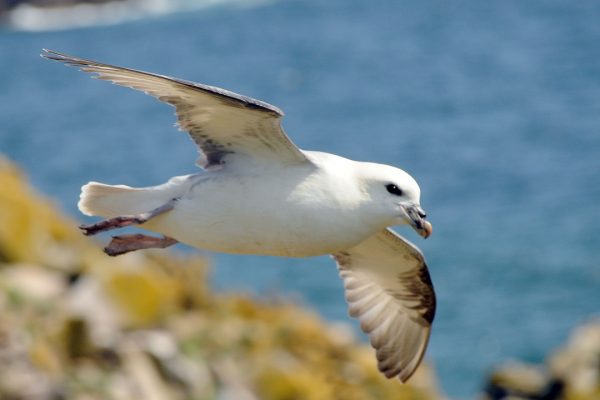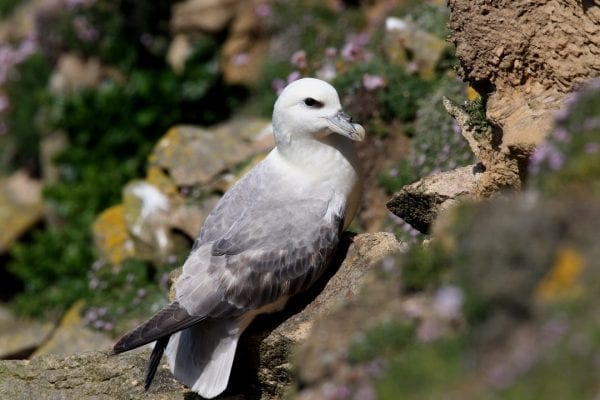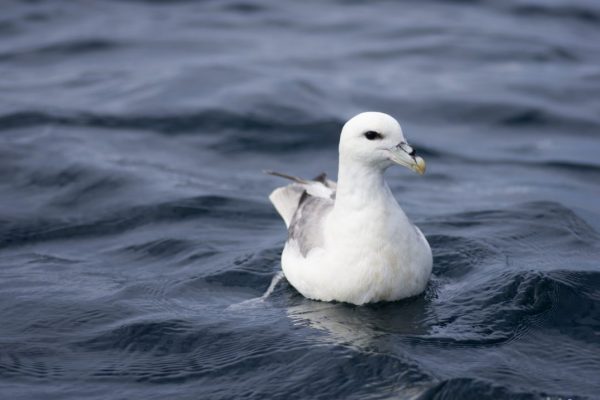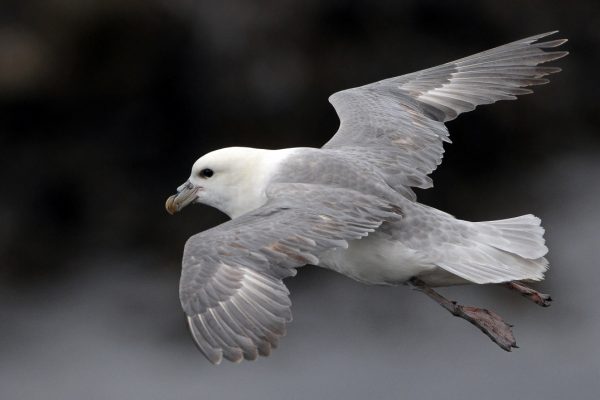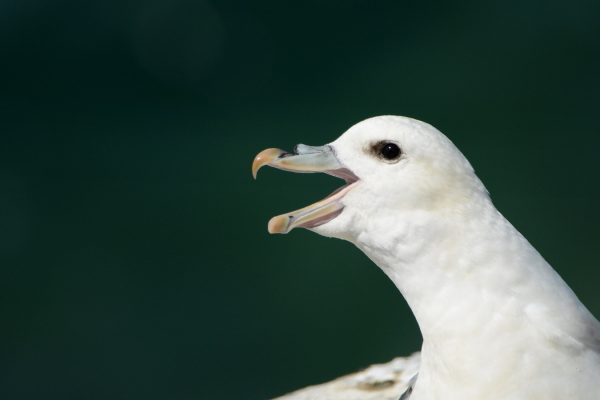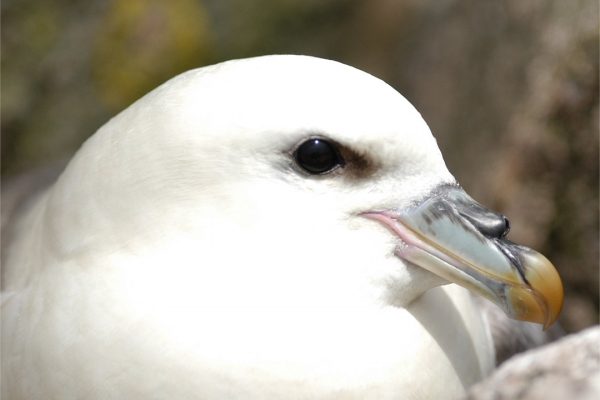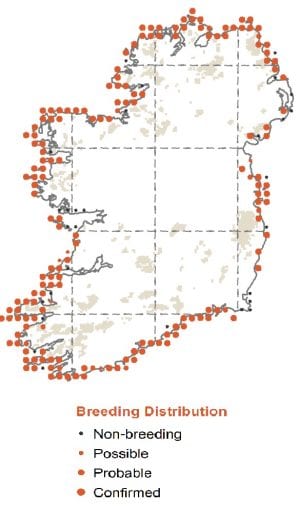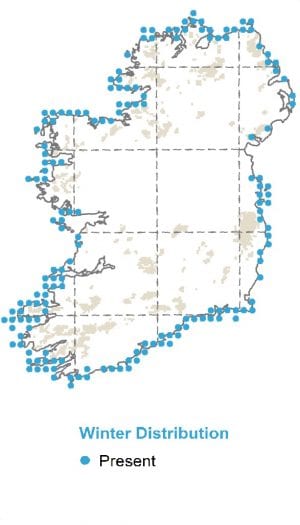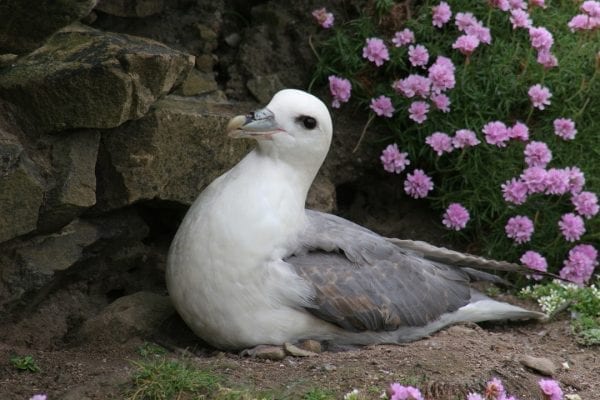
Fulmar
| Irish Name: | Fulmaire |
| Scientific name: | Fulmarus glacialis |
| Bird Family: | Tubenoses |
amber
Conservation status
Conservation status
Status
Resident along all Irish coasts.
Identification
A gull-like bird with white underparts and pale grey upperparts. Also occurs in darker morphs ('Blue Fulmars'), which are commoner in the north of its range but not in Ireland. Has a thick neck and large head. Shows a pale primary patch on the upperwing. Does not show gull-like black tips to the primary feathers. Straight, stout bill with hooked tip and tube shaped nostrils on the upper mandible, giving distinctive bill shape if seen at close range. Nostrils used to excrete salt. Flies with very stiff wings, uses long glides at sea, with series of stiff, shallow wing beats. Hangs in the wind in the fierce updrafts generated by steep cliffs, where it can even fly backwards. Cannot stand upright, so needs to launch itself from a high ledge or patters along surface of sea to become airborne.
Voice
Vocal at the breeding colonies, with pairs cackling to one another with a guttural throaty series of "Ga, ga, ga ..." sounds.
Diet
A great variety of food taken including fish, discards from trawlers, crustaceans and whale flesh.
Breeding
A bird that has expanded its breeding range throughout Ireland over the last century, beginning in Mayo in 1911. Comes to land in the day, unlike its relatives the shearwaters and other petrels. Mainly breeds on sea cliffs, but will nest on level ground, on buildings and in burrows and crevasses. Will use both steep rocky cliffs, grassy cliffs and steep slopes above cliffs. Both incubating adults and chick use projectile vomiting as a defensive against predators, the oily stomach contents effectively fouling the plumage of other birds.
Wintering
Winters at sea, but can be seen in Irish waters throughout the year. Attends colonies in the winter sporadically, with breeding cliffs deserted one week and full the next.
Monitored by
Breeding seabirds are monitored through seabird surveys carried out every 15-20 years.
Blog posts about this bird
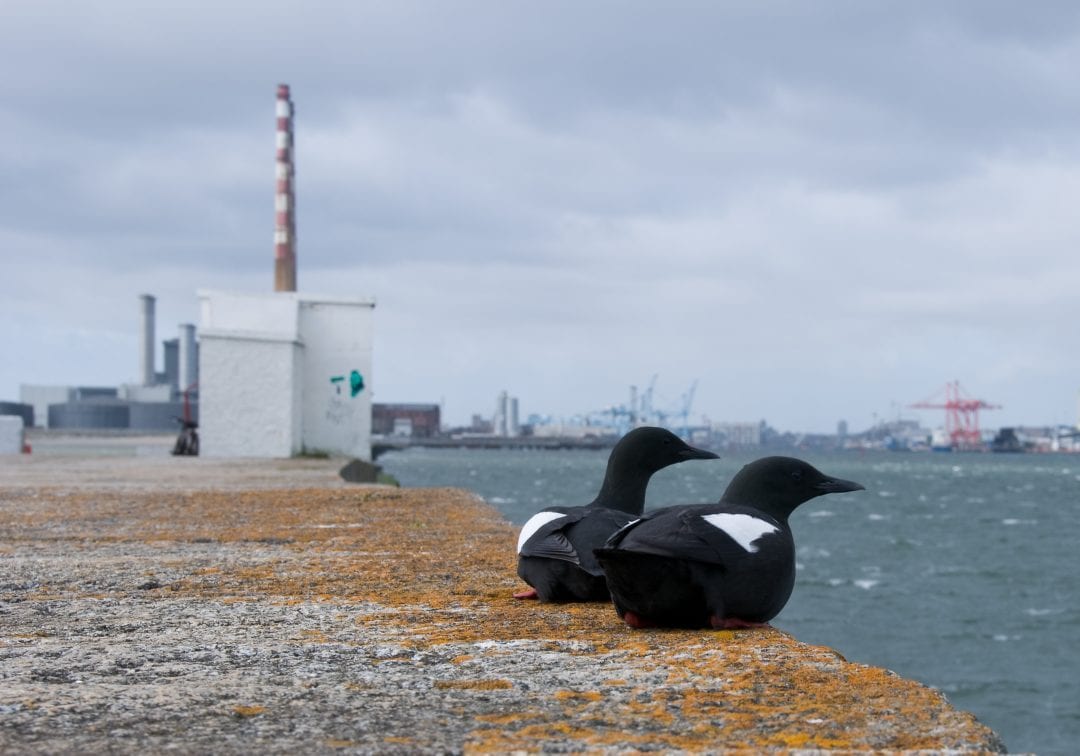
Embracing our maritime heritage this National Heritage Week
National Heritage Week takes place from 17th-25th August 2024. National Heritage Week celebrates Ireland’s cultural, built and natural heritage, uniting communities, cultural institutions, academics and organisations to build awareness about the value of heritage and support its conservation.
By Rosalind Skillen
Over the years, National Heritage Week has grown to become an island-wide event celebrating all aspects of our built, natural and cultural heritage.
It may be surprising to learn that policy related to the marine environment and foreshore section sits in the Department of Housing, Local Government and Heritage – not the Department of Environment, Climate and Communications, as some may assume. This reflects the fact that, as an island nation, our history and heritage have been shaped by the sea and Irish rivers, lakes, and wetlands.
It is also one of the primary reasons why the nine day-long National Heritage Week now includes a Water Heritage Day, held in partnership with the Local Authority Waters Programme. Water Heritage Day is happening on Sunday 25th August 2024 and the day celebrates water throughout Ireland, its history, heritage and our connections with it. It also gives us the opportunity to reflect on the importance of water to our daily lives and consider what more we can do to conserve this valuable resource.
The theme of this year’s National Heritage Week is “Connections, Routes and Networks”, inviting us to explore the ways we are connected to each other through physical or cultural connections.
When we think about the relationship between these three strands – heritage, the sea, and connection – there are several dimensions to this relationship. The sea connects us to the natural world. It also connects people, places, cultures and economies. It is a site of trade and transportation, an issue of mutual benefit and cooperation, and a home for many diverse ecosystems that are bound together in a complex web of ecological interdependence.
Take the Atlantic Ocean off the west coast of Ireland. To take the 2024 theme of “Connections, Routes and Networks”, the waters in the Atlantic transported millions of Irish emigrants to the New World in one of the most tragic periods of Ireland’s history. Where sea meets shore, the Atlantic is renowned for its stunning and rugged coastline, its deep maritime heritage, strong history of fishing, and its variable and windy weather. This is one of the most important coastlines for seabirds, with Galway Bay and surrounding islands hosting some of the largest aggregations of Kittiwake, an internationally important breeding population of Guillemot, as well as important colonies for Puffin, Razorbill and Fulmar. Further north in Mayo, the coastline contains breeding sites for Terns, Auks and Fulmar.
Covering 1/5 of the Earth’s surface, the Atlantic is not only part of Irish heritage but is also a connector. The Atlantic not only connects two continents and serves as a network for global trade, but it also is a route used by seabirds from the UK, Ireland and the US. Seabirds from all 3 nations use the Atlantic as a migration route for breeding and feeding, and there is data showing that US and Irish birds use one of our most important MPAs (NACES) nestled in the heart of the North Atlantic Ocean. In 2021, OSPAR designated NACES as an MPA following research led by BirdLife International, which used tracking data from 21 species of seabirds across 56 colonies. This tracking data revealed that 5 million birds, including Puffins that breed on Skellig Michael, use the NACES MPA every year, making the site a seabird hotspot. A “connector” in the truest sense, the site is one of the most significant congregations of migratory seabirds in the Atlantic.
Conclusion
As the summer draws to a close, with many looking forward to a new routine or the return of school, National Heritage Week offers an opportunity to look back and to appreciate our coasts, seaports and vast maritime area.
Crucially, protecting the marine environment will be vital to preserving our rich Irish heritage for future generations. At the time of writing, we are still waiting for the publication of national Marine Protected Area (MPA) Bill, a vital piece of legislation that would see 30% of Ireland’s water designated as MPAs by 2030, including 10% strictly protected. The MPA Bill was promised in the Programme for Government (2020), and multiple Government announcements and speeches thereafter. We need robust marine protection and effective management of Irish waters to protect the rich maritime heritage that we enjoy across Ireland, and to preserve it for more generations to come.
Find out more about Fair Seas campaign to protect 30% Irish seas by 2030:
FairSeas | Building a Movement of Ocean Stewardship
Find out more about events taking place during National Heritage Week:
Home | National Heritage Week 17th – 25th August 2024
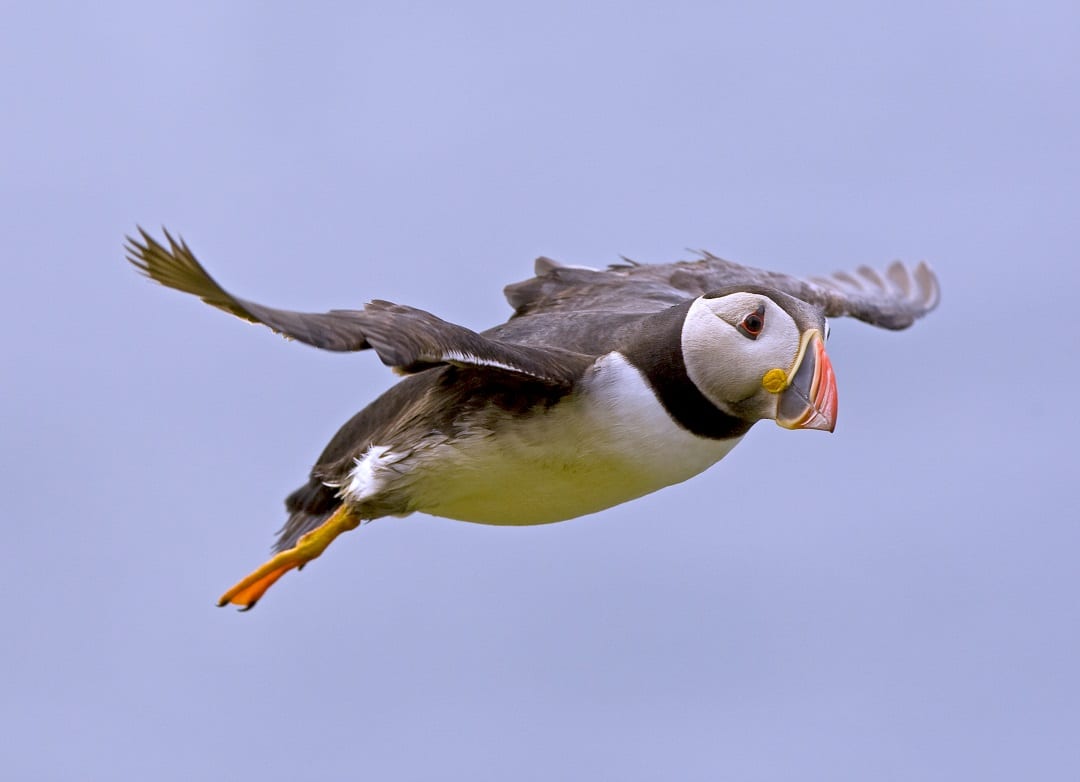
BirdWatch Ireland Nature Reserves to form part of Ireland’s first Marine National Park
BirdWatch Ireland is proud to partner with the National Parks and Wildlife Service (NPWS) and others in managing Ireland’s first Marine National Park – Páirc Náisiúnta na Mara, Ciarraí.
Announced on World Earth Day on Monday, April 22nd, the new National Park in Corca Dhuibhne, Co Kerry will unite some of Europe’s most ecologically valuable places across 70,000 acres of land and sea. These lands and waters provide extremely important nesting sites and food sources for seabirds including Red-listed species such as Puffin and Kittiwake and many other vulnerable Amber-listed species such as Manx Shearwater, Gannet and European Storm Petrel.
The Park will incorporate internationally important sites for seabirds such as BirdWatch Ireland managed Little Skellig and Puffin Island, as well as An Tiaracht Nature Reserve, which is managed by the Commissioners of Irish Lights.
It will also include new acquisitions by the National Parks and Wildlife Service (NPWS), such as the Conor Pass, the Owenmore River catchment, lands at Mount Brandon and the sand dune system at Inch Peninsula, along with sites already under State ownership, including the limestone reefs of Kerry Head Shoals and the waters around the Blasket Islands. The Páirc’s heritage legacy would be further enhanced by the inclusion of lands on the Great Blasket Island, the globally significant UNESCO World Heritage property of Sceilg Mhichíl, and Derrynane House, Historic Park and Beach, which are managed by the Office of Public Works (OPW).


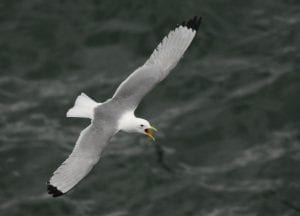
Kittiwake. Photo: John Fox.
Páirc Náisiúnta na Mara, Ciarraí was officially launched in Dingle on World Earth Day, with Jill Crosher from BirdWatch Ireland’s Corca Dhuibhne (West Kerry Gaeltacht) Branch serving as a proud local representative of BirdWatch Ireland at the event. In light of the announcement, CEO of BirdWatch Ireland Linda Lennon said: “We are delighted to announce our partnership on the new Páirc Náisiúnta na Mara, Ciarraí. This area, including BirdWatch Ireland’s Puffin Island and Little Skellig Nature Reserves, provides vital breeding and feeding sites to some of our most iconic and endangered seabirds. At BirdWatch Ireland, we are strong believers in the power of collaboration when it comes to making real change for our birds and wider biodiversity. We look forward to embarking on this new journey with our partners the NPWS, the OPW and the Commissioners of Irish Lights.” Speaking at the launch, Minister of State for Nature, Heritage and Electoral Reform, Malcolm Noonan said: “With the iconic Conor Pass as the gateway, Ireland’s first Marine National Park brings mountains, blanket bog, heaths, rivers, coastal dunes, limestone reefs, sea cliffs and some of the wildest land and seascapes in the country together in celebration of nature. Alongside its seven sister parks, Páírc Náisiúnta na Mara, Ciarraí will be a flagship for the protection and restoration of these incredible places and the globally important array of wildlife that they are home to. The Páirc will also honour the island and coastal communities who live alongside it by ensuring that their unique tapestry of cultural and natural heritage is central to the future story of this special place.” Niall Ó Donnchú, Director General of the National Parks and Wildlife Service said: “Our new park is a celebration of heritage in all its forms. Our biodiversity and natural heritage sit layered in harmony alongside monuments and historic wrecks from many periods. This is a place of iconic significance and majestic beauty. At times, shrouded in mist as a far outpost, ethereal in its past, evocative in its firing of the imagination, and vital in its biodiversity. Undoubtedly, a place of local pride and universal value. We look forward to working with our partners, the Office of Public Works, the National Monuments Service, the Commissioners for Irish Lights, Birdwatch Ireland, Kerry County Council and the local communities to realise a truly world-class National Park.”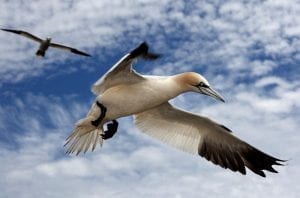
Gannet. Photo: Gerry Kerr.
Established in 1983, Puffin Island Nature Reserve off the southwest tip of Kerry is a summer home to many cliff- and burrow-nesting birds. As its name suggests, the island hosts many Puffins, with thousands of pairs of this Red-listed Bird of Conservation Concern nesting there every summer. The island also holds one of the largest colonies of Manx Shearwater in the country, with large numbers of Storm Petrel also breeding here. Fulmar, Guillemot and Razorbill are some of the many other species for which this site is important. Owned and managed by BirdWatch Ireland, Puffin Island Nature Reserve is already a Special Area of Protection (SPA) under the European Birds Directive and an Important Bird Area (IBA) as identified by BirdLife International. The inclusion of the reserve in Páirc Náisiúnta na Mara adds another layer of protection to this vitally important site for birds. The Little Skellig Nature Reserve is an iconic BirdWatch Ireland nature reserve famed for its colony of some 35,000 pairs of Gannets – the largest breeding colony in Ireland and among the largest in the world. There are also smaller numbers of Guillemot, Puffin and Kittiwake present. Both Little Skellig and the adjacent Skellig Michael are protected by a Special Protection Area, designated under the European Union Birds Directive. These islands also form one of Ireland’s Important Bird Areas. While seabirds are highly dependent on Puffin Island and Little Skellig in order to breed, they also rely on the surrounding seas as a food source so it is vitally important that they receive protection. The announcement of Páirc Náisiúnta na Mara, Ciarraí is a step forward for seabirds, and the many other species that share these habitats with them.
